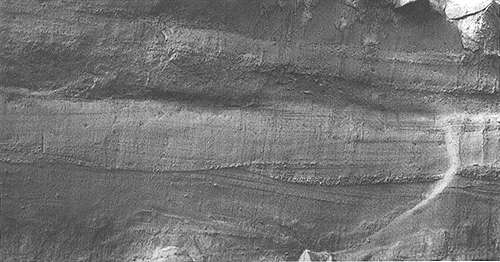
Wave-produced scours
Plate 78

Wave-produced scours
Plate 78
Here again is an example of hummocky cross-lamination (see plate 47) in fine-grained littoral sandstones. The concavo-convex laminaset at the center displays a nice hummock of accretionary laminae resting on scalloped, multiple scour. The scoured surface, and part the overlying laminae, are underlined by shell debris. It apparently shifted from right to left.
Plate 78 is a close-up of a vertical cliff, where no scale could be placed.
Pliocene Intra-apenninic Basin, Zena Valley, northern Apennines.
Generally speaking, coarse particles that pave an erosional surface are called lag deposits . They, in fact, lag behind smaller particles that the flows are able to entrain with them, and represent trapped, residual materials. When a stream erodes its bedrock, for example, pebbles can be trapped by minor topographic irregularities. Or, pebbles transported by a high-energy flow, then deposited in a sand bed, are freed (exhumed) by a gentler current that removes the sand.
A lag pavement can be continuous or spotty, and is commonly the result of more than one event. In other terms, it records, in many cases, the passage of several currents, and hence a zone of bypass and a time of nondeposition. This implies a time gap of possible geological significance along erosional surfaces paved by lag materials. Scour-and-fill structures have no or little lag deposits, because deposition occurs soon after erosion. Lag deposits are thus features suggestive of diachronous erosional surfaces, including paleochannels.